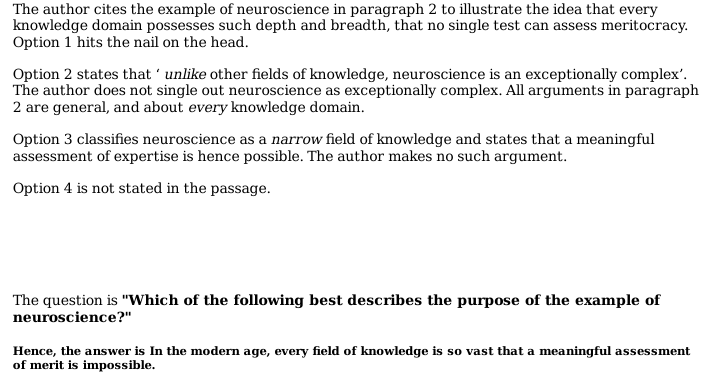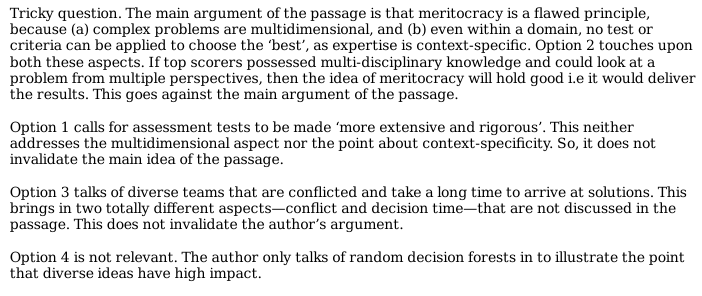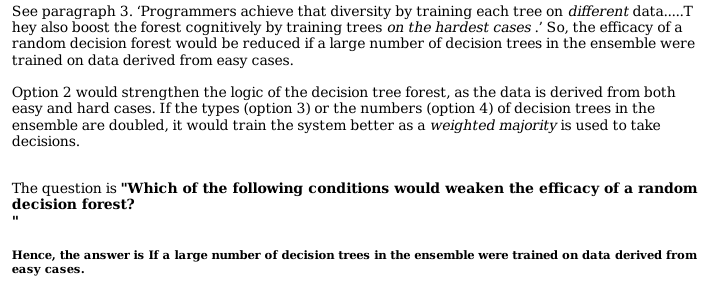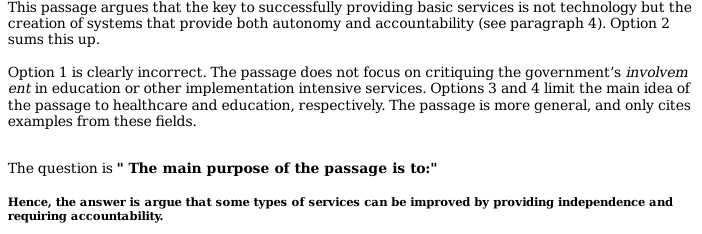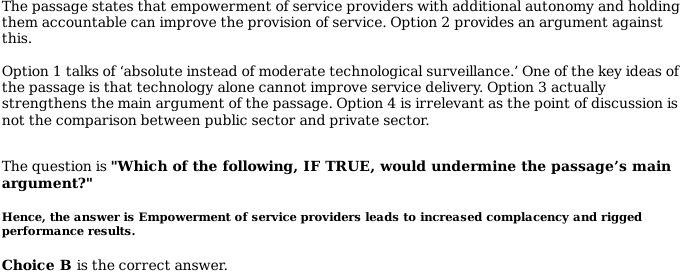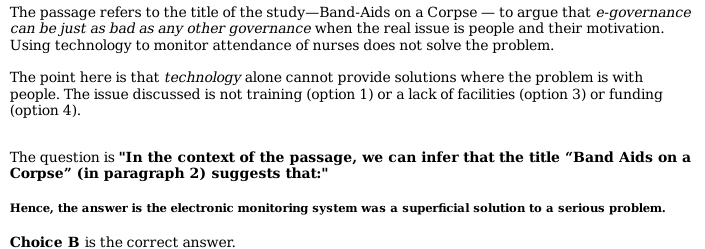Live Updates
• CATKing has launched new chat bot.

• New video on Logs has been released.
13.2K
Learners
asked the doubt

Previous Year Questions
Which one of the following options does NOT represent the characteristics of the western barred bandicoot?
Video Explanation

According to the text, the western barred bandicoots now have a flattering name because they have
Video Explanation

Read the given passage and answer the questions that follow.
Landing in Australia, the British colonists weren't much impressed with the small-bodied, slender-snooted marsupials called bandicoots. "Their muzzle, which is much too long, gives them an air exceedingly stupid," one naturalist noted in 1805. They nicknamed one type the "zebra rat" because of its black-striped rump.
Silly-looking or not, though, the zebra rat—the smallest bandicoot, more commonly known today as the western barred bandicoot—exhibited a genius for survival in the harsh outback, where its ancestors had persisted for some 26 million years. Its births were triggered by rainfall in the bone-dry desert. It carried its breath-mint-size babies in a backward-facing pouch so mothers could forage for food and dig shallow, camouflaged shelters.
Still, these adaptations did not prepare the western barred bandicoot for the colonial-era transformation of its ecosystem, particularly the onslaught of imported British animals, from cattle and rabbits that damaged delicate desert vegetation to ravenous house cats that soon developed a taste for bandicoots. Several of the dozen-odd bandicoot species went extinct, and by the 1940s the western barred bandicoot, whose original range stretched across much of the continent, persisted only on two predator-free islands in Shark Bay, off Australia's western coast.
"Our isolated fauna had simply not been exposed to these predators," says Reece Pedler, an ecologist with the Wild Deserts conservation program.
Now Wild Deserts is using descendants of those few thousand island survivors, called Shark Bay bandicoots, in a new effort to seed a mainland bandicoot revival. They've imported 20 bandicoots to a preserve on the edge of the Strzelecki Desert, in the remote interior of New South Wales. This sanctuary is a challenging place, desolate much of the year, with one of the world's most mercurial rainfall patterns—relentless droughts followed by sudden drenching floods.
The imported bandicoots occupy two fenced "exclosures," cleared of invasive rabbits (courtesy of Pedler's sheepdog) and of feral cats (which slunk off once the rabbits disappeared). A third fenced area contains the program's Wild Training Zone, where two other rare marsupials (bilbies, a larger type of bandicoot, and mulgaras, a somewhat fearsome fuzzball known for sucking the brains out of prey) currently share terrain with controlled numbers of cats, learning to evade them. It's unclear whether the Shark Bay bandicoots, which are perhaps even more predator-naive than their now-extinct mainland bandicoot kin, will be able to make that kind of breakthrough.
For now, though, a recent surge of rainfall has led to a bandicoot joey boom, raising the Wild Deserts population to about 100, with other sanctuaries adding to that number. There are also signs of rebirth in the landscape itself. With their constant digging, the bandicoots trap moisture and allow for seed germination so the cattle-damaged desert can restore itself.
They have a new nickname—a flattering one, this time. "We call them ecosystem engineers," Pedler says.
According to the text, the western barred bandicoots now have a flattering name because they have
Video Explanation

Which one of the following options does NOT represent the characteristics of the western barred bandicoot?
Video Explanation

The author claims that, "The apparent veil between the organic and the manufactured has crumpled to reveal that the two really are, and have always been, of one being." Which one of the following statements best expresses the point being made by the author here?
Video Explanation

None of the following statements is implied by the arguments of the passage, EXCEPT:
Video Explanation

Which one of the following sets of words/phrases best serves as keywords to the passage?
Video Explanation

The author claims that, "Part of this bionic convergence is a matter of words". Which one of the following statements best expresses the point being made by the author?
Video Explanation

The passage below is accompanied by a set of questions. Choose the best answer to each question.
Nature has all along yielded her flesh to humans. First, we took nature's materials as food, fibers, and shelter. Then we learned to extract raw materials from her biosphere to create our own new synthetic materials. Now Bios is yielding us her mind-we are taking her logic.
Clockwork logic-the logic of the machines-will only build simple contraptions. Truly complex systems such as a cell, a meadow, an economy, or a brain (natural or artificial) require a rigorous nontechnological logic. We now see that no logic except bio-logic can assemble a thinking device, or even a workable system of any magnitude.
It is an astounding discovery that one can extract the logic of Bios out of biology and have something useful. Although many philosophers in the past have suspected one could abstract the laws of life and apply them elsewhere, it wasn't until the complexity of computers and human-made systems became as complicated as living things, that it was possible to prove this. It's eerie how much of life can be transferred. So far, some of the traits of the living that have successfully been transported to mechanical systems are: self-replication, self-governance, limited self-repair, mild evolution, and partial learning.
We have reason to believe yet more can be synthesized and made into something new. Yet at the same time that the logic of Bios is being imported into machines, the logic of Technos is being imported into life. The root of bioengineering is the desire to control the organic long enough to improve it. Domesticated plants and animals are examples of technos-logic applied to life. The wild aromatic root of the Queen Anne's lace weed has been fine-tuned over generations by selective herb gatherers until it has evolved into a sweet carrot of the garden; the udders of wild bovines have been selectively enlarged in a "unnatural" way to satisfy humans rather than calves. Milk cows and carrots, therefore, are human inventions as much as steam engines and gunpowder are. But milk cows and carrots are more indicative of the kind of inventions humans will make in the future: products that are grown rather than manufactured.
Genetic engineering is precisely what cattle breeders do when they select better strains of Holsteins, only bioengineers employ more precise and powerful control. While carrot and milk cow breeders had to rely on diffuse organic evolution, modern genetic engineers can use directed artificial evolution-purposeful design-which greatly accelerates improvements.
The overlap of the mechanical and the lifelike increases year by year. Part of this bionic convergence is a matter of words. The meanings of "mechanical" and "life" are both stretching until all complicated things can be perceived as machines, and all self-sustaining machines can be perceived as alive. Yet beyond semantics, two concrete trends are happening: (1) Human-made things are behaving more lifelike, and (2) Life is becoming more engineered. The apparent veil between the organic and the manufactured has crumpled to reveal that the two really are, and have always been, of one being.
The author claims that, "Part of this bionic convergence is a matter of words". Which one of the following statements best expresses the point being made by the author?
Video Explanation

Which one of the following sets of words/phrases best serves as keywords to the passage?
Video Explanation

None of the following statements is implied by the arguments of the passage, EXCEPT:
Video Explanation

The author claims that, "The apparent veil between the organic and the manufactured has crumpled to reveal that the two really are, and have always been, of one being." Which one of the following statements best expresses the point being made by the author here?
Video Explanation

On the basis of the passage, which of the following teams is likely to be most effective in solving the problem of rising obesity levels?
Video Explanation

Which of the following best describes the purpose of the example of neuroscience?
Video Explanation

Which of the following conditions, if true, would invalidate the passage’s main argument?
Video Explanation

Which of the following conditions would weaken the efficacy of a random decision forest?
Video Explanation

The author critiques meritocracy for all the following reasons EXCEPT that:
Video Explanation

The complexity of modern problems often precludes any one person from fully understanding them. Factors contributing to rising obesity levels, for example, include transportation systems and infrastructure, media, convenience foods, changing social norms, human biology and psychological factors. The multidimensional or layered character of complex problems also undermines the principle of meritocracy: the idea that the ‘best person’ should be hired. There is no best person. When putting together an oncological research team, a biotech company such as Gilead or Genentech would not construct a multiple-choice test and hire the top scorers, or hire people whose resumes score highest according to some performance criteria. Instead, they would seek diversity. They would build a team of people who bring diverse knowledge bases, tools and analytic skills.
Believers in a meritocracy might grant that teams ought to be diverse but then argue that meritocratic principles should apply within each category. Thus the team should consist of the ‘best’ mathematicians, the ‘best’ oncologists, and the ‘best’ biostatisticians from within the pool. That position suffers from a similar flaw.
Even with a knowledge domain, no test or criteria applied to individuals will produce the best team. Each of these domains possesses such depth and breadth, that no test can exist. Consider the field of neuroscience. Upwards of 50,000 papers were published last year covering various techniques, domains of enquiry and levels of analysis, ranging from molecules and synapses up through networks of neurons. Given that complexity, any attempt to rank a collection of neuroscientists from best to worst, as if they were competitors in the 50-metre butterfly, must fail. What could be true is that given a specific task and the composition of a particular team, one scientist would be more likely to contribute than another. Optimal hiring depends on context. Optimal teams will be diverse.
Evidence for this claim can be seen in the way that papers and patents that combine diverse ideas tend to rank as high-impact. It can also be found in the structure of the so-called random decision forest, a state-of-the-art machine-learning algorithm.
Random forests consist of ensembles of decision trees. If classifying pictures, each tree makes a vote: is that a picture of a fox or a dog? A weighted majority rules. Random forests can serve many ends. They can identify bank fraud and diseases, recommend ceiling fans and predict online dating behaviour. When building a forest, you do not select the best trees as they tend to make similar classifications. You want diversity. Programmers achieve that diversity by training each tree on different data, a technique known as bagging. They also boost the forest ‘cognitively’ by training trees on the hardest cases – those that the current forest gets wrong. This ensures even more diversity and accurate forests."
Yet the fallacy of meritocracy persists. Corporations, non-profits, governments, universities and even preschools test, score and hire the ‘best’. This all but guarantees not creating the best team. Ranking people by common criteria produces homogeneity. That’s not likely to lead to breakthroughs.
The author critiques meritocracy for all the following reasons EXCEPT that:
Video Explanation

Which of the following conditions would weaken the efficacy of a random decision forest?
Video Explanation

Which of the following conditions, if true, would invalidate the passage’s main argument?
Video Explanation

On the basis of the passage, which of the following teams is likely to be most effective in solving the problem of rising obesity levels?
Video Explanation

Which of the following best describes the purpose of the example of neuroscience?
Video Explanation

In paragraph 4, the evidence that “humans routinely ate these types of snails before the advent of agriculture” can be used to conclude that:
Video Explanation

Which one of the following makes the author eliminate convergent evolution as a probable explanation for why white-lipped grove snails are found in Ireland and the Pyrenees?
Video Explanation

The passage outlines several hypotheses and evidence related to white-lipped grove snails to arrive at the most convincing explanation for:
Video Explanation

All of the following evidence supports the passage’s explanation of sea travel/trade EXCEPT:
Video Explanation

Grove snails as a whole are distributed all over Europe, but a specific variety of the snail, with a distinctive white-lipped shell, is found exclusively in Ireland and in the Pyrenees mountains that lie on the border between France and Spain. The researchers sampled a total of 423 snail specimens from 36 sites distributed across Europe, with an emphasis on gathering large numbers of the white-lipped variety. When they sequenced genes from the mitochondrial DNA of each of these snails and used algorithms to analyze the genetic diversity between them, they found that a distinct lineage (the snails with the white-lipped shells) was indeed endemic to the two very specific and distant places in question.
Explaining this is tricky. Previously, some had speculated that the strange distributions of creatures such as the white-lipped grove snails could be explained by convergent evolution—in which two populations evolve the same trait by coincidence—but the underlying genetic similarities between the two groups rules that out. Alternately, some scientists had suggested that the white-lipped variety had simply spread over the whole continent, then been wiped out everywhere besides Ireland and the Pyrenees, but the researchers say their sampling and subsequent DNA analysis eliminate that possibility too.
“If the snails naturally colonized Ireland, you would expect to find some of the same genetic type in other areas of Europe, especially Britain. We just don’t find them,” Davidson, the lead author, said in a press statement.
Moreover, if they’d gradually spread across the continent, there would be some genetic variation within the white-lipped type, because evolution would introduce variety over the thousands of years it would have taken them to spread from the Pyrenees to Ireland. That variation doesn’t exist, at least in the genes sampled. This means that rather than the organism gradually expanding its range, large populations instead were somehow moved en mass to the other location within the space of a few dozen generations, ensuring a lack of genetic variety.
“There is a very clear pattern, which is difficult to explain except by involving humans,” Davidson said. Humans, after all, colonized Ireland roughly 9,000 years ago, and the oldest fossil evidence of grove snails in Ireland dates to roughly the same era. Additionally, there is archaeological evidence of early sea trade between the ancient peoples of Spain and Ireland via the Atlantic and even evidence that humans routinely ate these types of snails before the advent of agriculture, as their burnt shells have been found in Stone Age trash heaps.
The simplest explanation, then? Boats. These snails may have inadvertently traveled on the floor of the small, coast-hugging skiffs these early humans used for travel, or they may have been intentionally carried to Ireland by the seafarers as a food source. “The highways of the past were rivers and the ocean–as the river that flanks the Pyrenees was an ancient trade route to the Atlantic, what we’re actually seeing might be the long lasting legacy of snails that hitched a ride as humans travelled from the South of France to Ireland 8,000 years ago,” Davidson said.
All of the following evidence supports the passage’s explanation of sea travel/trade EXCEPT:
Video Explanation

The passage outlines several hypotheses and evidence related to white-lipped grove snails to arrive at the most convincing explanation for:
Video Explanation

Which one of the following makes the author eliminate convergent evolution as a probable explanation for why white-lipped grove snails are found in Ireland and the Pyrenees?
Video Explanation

In paragraph 4, the evidence that “humans routinely ate these types of snails before the advent of agriculture” can be used to conclude that:
Video Explanation

The author questions the use of monitoring systems in services that involve face-to-face interaction between service providers and clients because such systems:
Video Explanation

Which of the following, IF TRUE, would undermine the passage’s main argument?
Video Explanation

According to the author, service delivery in Indian education can be improved in all of the following ways EXCEPT through:
Video Explanation

In the context of the passage, we can infer that the title “Band Aids on a Corpse” (in paragraph 2) suggests that:
Video Explanation

Will a day come when India’s poor can access government services as easily as drawing cash from an ATM? No country in the world has made accessing education or health or policing or dispute resolution as easy as an ATM, because the nature of these activities requires individuals to use their discretion in a positive way. Technology can certainly facilitate this in a variety of ways if it is seen as one part of an overall approach, but the evidence so far in education, for instance, is that just adding computers alone doesn’t make education any better.
The dangerous illusion of technology is that it can create stronger, top down accountability of service providers in implementation-intensive services within existing public sector organisations. One notion is that electronic management information systems (EMIS) keep better track of inputs and those aspects of personnel that are ‘EMIS visible’ can lead to better services. A recent study examined attempts to increase attendance of Auxiliary Nurse Midwife (ANMs) at clinics in Rajasthan, which involved high-tech time clocks to monitor attendance. The study’s title says it all: Band-Aids on a Corpse. E-governance can be just as bad as any other governance when the real issue is people and their motivation.
For services to improve, the people providing the services have to want to do a better job with the skills they have. A study of medical care in Delhi found that even though providers, in the public sector had much better skills than private sector providers their provision of care in actual practice was much worse.
In implementation-intensive services the key to success is face-to-face interactions between a teacher, a nurse, a policeman, an extension agent and a citizen. This relationship is about power. Amartya Sen’s report on education in West Bengal had a supremely telling anecdote in which the villagers forced the teacher to attend school, but then, when the parents went off to work, the teacher did not teach, but forced the children to massage his feet. As long as the system empowers providers over citizens, technology is irrelevant.
The answer to successfully providing basic services is to create systems that provide both autonomy and accountability. In basic education for instance, the answer to poor teaching is not controlling teachers more. The key is to hire teachers who want to teach and let them teach, expressing their professionalism and vocation as a teacher through autonomy in the classroom. This autonomy has to be matched with accountability for results—not just narrowly measured through test scores, but broadly for the quality of the education they provide.
A recent study in Uttar Pradesh showed that if, somehow, all civil service teachers could be replaced with contract teachers, the state could save a billion dollars a year in revenue and double student learning. Just the additional autonomy and accountability of contracts through local groups—even without complementary system changes in information and empowerment—led to that much improvement. The first step to being part of the solution is to create performance information accessible to those outside of the government.
In the context of the passage, we can infer that the title “Band Aids on a Corpse” (in paragraph 2) suggests that:
Video Explanation

According to the author, service delivery in Indian education can be improved in all of the following ways EXCEPT through:
Video Explanation

Which of the following, IF TRUE, would undermine the passage’s main argument?
Video Explanation

The author questions the use of monitoring systems in services that involve face-to-face interaction between service providers and clients because such systems:
Video Explanation

Which one of the following cannot be inferred from Alexandra Schnell's experiment?
Video Explanation

Which one of the following, if true, would best complement the passage's findings?
Video Explanation

The passage below is accompanied by a set of questions. Choose the best answer to each question.
Cuttlefish are full of personality, as behavioral ecologist Alexandra Schnell found out while researching the cephalopod's potential to display self-control. . . . "Self-control is thought to be the cornerstone of intelligence, as it is an important prerequisite for complex decision-making and planning for the future," says Schnell . . .
[Schnell's] study used a modified version of the "marshmallow test" . . . During the original marshmallow test, psychologist Walter Mischel presented children between age four and six with one marshmallow. He told them that if they waited 15 minutes and didn't eat it, he would give them a second marshmallow. A long-term follow-up study showed that the children who waited for the second marshmallow had more success later in life. . . . The cuttlefish version of the experiment looked a lot different. The researchers worked with six cuttlefish under nine months old and presented them with seafood instead of sweets. (Preliminary experiments showed that cuttlefishes' favorite food is live grass shrimp, while raw prawns are so-so and Asian shore crab is nearly unacceptable.) Since the researchers couldn't explain to the cuttlefish that they would need to wait for their shrimp, they trained them to recognize certain shapes that indicated when a food item would become available. The symbols were pasted on transparent drawers so that the cuttlefish could see the food that was stored inside. One drawer, labeled with a circle to mean "immediate," held raw king prawn. Another drawer, labeled with a triangle to mean "delayed," held live grass shrimp. During a control experiment, square labels meant "never."
"If their self-control is flexible and I hadn't just trained them to wait in any context, you would expect the cuttlefish to take the immediate reward [in the control], even if it's their second preference," says Schnell . . . and that's what they did. That showed the researchers that cuttlefish wouldn't reject the prawns if it was the only food available. In the experimental trials, the cuttlefish didn't jump on the prawns if the live grass shrimp were labeled with a triangle”many waited for the shrimp drawer to open up. Each time the cuttlefish showed it could wait, the researchers tacked another ten seconds on to the next round of waiting before releasing the shrimp. The longest that a cuttlefish waited was 130 seconds.
Schnell [says] that the cuttlefish usually sat at the bottom of the tank and looked at the two food items while they waited, but sometimes, they would turn away from the king prawn "as if to distract themselves from the temptation of the immediate reward." In past studies, humans, chimpanzees, parrots and dogs also tried to distract themselves while waiting for a reward.
Not every species can use self-control, but most of the animals that can share another trait in common: long, social lives. Cuttlefish, on the other hand, are solitary creatures that don't form relationships even with mates or young. . . . "We don't know if living in a social group is important for complex cognition unless we also show those abilities are lacking in less social species," says . . . comparative psychologist Jennifer Vonk.
All of the following constitute a point of difference between the "original" and "modified" versions of the marshmallow test EXCEPT that:
Video Explanation

Which one of the following, if true, would best complement the passage's findings?
Video Explanation

In which one of the following scenarios would the cuttlefish's behaviour demonstrate self-control?
Video Explanation

Which one of the following cannot be inferred from Alexandra Schnell's experiment?
Video Explanation

All of the following constitute a point of difference between the "original" and "modified" versions of the marshmallow test EXCEPT that:
Video Explanation

In which one of the following scenarios would the cuttlefish's behaviour demonstrate self-control?
Video Explanation

All of the following arguments are made in the passage EXCEPT that:
Video Explanation

All of the following statements can be inferred from the passage EXCEPT that:
Video Explanation

Which sequence of words below best captures the narrative of the passage?
Video Explanation

Following from the passage, which one of the following may be seen as a characteristic of a utopian society?
Video Explanation

The passage below is accompanied by a set of questions. Choose the best answer to each question.
We cannot travel outside our neighbourhood without passports. We must wear the same plain clothes. We must exchange our houses every ten years. We cannot avoid labour. We all go to bed at the same time . . . We have religious freedom, but we cannot deny that the soul dies with the body, since 'but for the fear of punishment, they would have nothing but contempt for the laws and customs of society'. . . . In More's time, for much of the population, given the plenty and security on offer, such restraints would not have seemed overly unreasonable. For modern readers, however, Utopia appears to rely upon relentless transparency, the repression of variety, and the curtailment of privacy. Utopia provides security: but at what price? In both its external and internal relations, indeed, it seems perilously dystopian.
Such a conclusion might be fortified by examining selectively the tradition which follows More on these points. This often portrays societies where . . . 'it would be almost impossible for man to be depraved, or wicked'. . . . This is achieved both through institutions and mores, which underpin the common life. . . . The passions are regulated and inequalities of wealth and distinction are minimized. Needs, vanity, and emulation are restrained, often by prizing equality and holding riches in contempt. The desire for public power is curbed. Marriage and sexual intercourse are often controlled: in Tommaso Campanella's The City of the Sun (1623), the first great literary utopia after More's, relations are forbidden to men before the age of twenty-one and women before nineteen. Communal child-rearing is normal; for Campanella this commences at age two. Greater simplicity of life, 'living according to nature', is often a result: the desire for simplicity and purity are closely related. People become more alike in appearance, opinion, and outlook than they often have been. Unity, order, and homogeneity thus prevail at the cost of individuality and diversity. This model, as J. C. Davis demonstrates, dominated early modern utopianism. . . . And utopian homogeneity remains a familiar theme well into the twentieth century.
Given these considerations, it is not unreasonable to take as our starting point here the hypothesis that utopia and dystopia evidently share more in common than is often supposed. Indeed, they might be twins, the progeny of the same parents. Insofar as this proves to be the case, my linkage of both here will be uncomfortably close for some readers. Yet we should not mistake this argument for the assertion that all utopias are, or tend to produce, dystopias. Those who defend this proposition will find that their association here is not nearly close enough. For we have only to acknowledge the existence of thousands of successful intentional communities in which a cooperative ethos predominates and where harmony without coercion is the rule to set aside such an assertion. Here the individual's submersion in the group is consensual (though this concept is not unproblematic). It results not in enslavement but voluntary submission to group norms. Harmony is achieved without . . . harming others.
Following from the passage, which one of the following may be seen as a characteristic of a utopian society?
Video Explanation

Which sequence of words below best captures the narrative of the passage?
Video Explanation

All of the following statements can be inferred from the passage EXCEPT that:
Video Explanation

All of the following arguments are made in the passage EXCEPT that:
Video Explanation

Which one of the following best explains the "additional complexity" that the example of the incense burner illustrates regarding personhood for the Classic Maya?
Video Explanation

Which one of the following, if true about the Classic Maya, would invalidate the purpose of the iPhone example in the passage?
Video Explanation

On the basis of the passage, which one of the following worldviews can be inferred to be closest to that of the Classic Maya?
Video Explanation

Which one of the following, if true, would not undermine the democratising potential of the Classic Maya worldview?
Video Explanation

The passage below is accompanied by a set of questions. Choose the best answer to each question.
For the Maya of the Classic period, who lived in Southern Mexico and Central America between 250 and 900 CE, the category of 'persons' was not coincident with human beings, as it is for us. That is, human beings were persons “ but other, nonhuman entities could be persons, too. . . . In order to explore the slippage of categories between 'humans' and 'persons', I examined a very specific category of ancient Maya images, found painted in scenes on ceramic vessels. I sought out instances in which faces (some combination of eyes, nose, and mouth) are shown on inanimate objects. . . . Consider my iPhone, which needs to be fed with electricity every night, swaddled in a protective bumper, and enjoys communicating with other fellow-phone-beings. Does it have personhood (if at all) because it is connected to me, drawing this resource from me as an owner or source? For the Maya (who did have plenty of other communicating objects, if not smartphones), the answer was no. Nonhuman persons were not tethered to specific humans, and they did not derive their personhood from a connection with a human. . . . It's a profoundly democratising way of understanding the world. Humans are not more important persons “ we are just one of many kinds of persons who inhabit this world. . . .
The Maya saw personhood as 'activated' by experiencing certain bodily needs and through participation in certain social activities. For example, among the faced objects that I examined, persons are marked by personal requirements (such as hunger, tiredness, physical closeness), and by community obligations (communication, interaction, ritual observance). In the images I examined, we see, for instance, faced objects being cradled in humans' arms; we also see them speaking to humans. These core elements of personhood are both turned inward, what the body or self of a person requires, and outward, what a community expects of the persons who are a part of it, underlining the reciprocal nature of community membership. . . .
Personhood was a nonbinary proposition for the Maya. Entities were able to be persons while also being something else. The faced objects I looked at indicate that they continue to be functional, doing what objects do (a stone implement continues to chop, an incense burner continues to do its smoky work). Furthermore, the Maya visually depicted many objects in ways that indicated the material category to which they belonged “ drawings of the stone implement show that a person-tool is still made of stone. One additional complexity: the incense burner (which would have been made of clay, and decorated with spiky appliques representing the sacred ceiba tree found in this region) is categorised as a person “ but also as a tree. With these Maya examples, we are challenged to discard the person/nonperson binary that constitutes our basic ontological outlook. . . . The porousness of boundaries that we have seen in the Maya world points towards the possibility of living with a certain uncategorisability of the world.
Which one of the following, if true about the Classic Maya, would invalidate the purpose of the iPhone example in the passage?
Video Explanation

Which one of the following, if true, would not undermine the democratising potential of the Classic Maya worldview?
Video Explanation

On the basis of the passage, which one of the following worldviews can be inferred to be closest to that of the Classic Maya?
Video Explanation

Which one of the following best explains the "additional complexity" that the example of the incense burner illustrates regarding personhood for the Classic Maya?
Video Explanation

Today, "conflat[ing] consumption with virtue" can be seen in the marketing of:
Video Explanation

According to this book review, A Thirst for Empire says that, in addition to "profit-motivated marketers", tea drinking was promoted in Britain by all of the following EXCEPT:
Video Explanation

This book review argues that, according to Rappaport, tea is unlike other "morality" products because it:
Video Explanation

The author of this book review is LEAST likely to support the view that:
Video Explanation

The passage below is accompanied by a set of questions. Choose the best answer to each question.
The sleights of hand that conflate consumption with virtue are a central theme in A Thirst for Empire, a sweeping and richly detailed history of tea by the historian Erika Rappaport. How did tea evolve from an obscure "China drink" to a universal beverage imbued with civilising properties? The answer, in brief, revolves around this conflation, not only by profit-motivated marketers but by a wide variety of interest groups. While abundant historical records have allowed the study of how tea itself moved from east to west, Rappaport is focused on the movement of the idea of tea to suit particular purposes.
Beginning in the 1700s, the temperance movement advocated for tea as a pleasure that cheered but did not inebriate, and industrialists soon borrowed this moral argument in advancing their case for free trade in tea (and hence more open markets for their textiles). Factory owners joined in, compelled by the cause of a sober workforce, while Christian missionaries discovered that tea "would soothe any colonial encounter". During the Second World War, tea service was presented as a social and patriotic activity that uplifted soldiers and calmed refugees.
But it was tea's consumer-directed marketing by importers and retailers “ and later by brands “ that most closely portends current trade debates. An early version of the "farm to table" movement was sparked by anti-Chinese sentiment and concerns over trade deficits, as well as by the reality and threat of adulterated tea containing dirt and hedge clippings. Lipton was soon advertising "from the Garden to Tea Cup" supply chains originating in British India and supervised by "educated Englishmen". While tea marketing always presented direct consumer benefits (health, energy, relaxation), tea drinkers were also assured that they were participating in a larger noble project that advanced the causes of family, nation and civilization. . . .
Rappaport's treatment of her subject is refreshingly apolitical. Indeed, it is a virtue that readers will be unable to guess her political orientation: both the miracle of markets and capitalism's dark underbelly are evident in tea's complex story, as are the complicated effects of British colonialism. . . . Commodity histories are now themselves commodities: recent works investigate cotton, salt, cod, sugar, chocolate, paper and milk. And morality marketing is now a commodity as well, applied to food, "fair trade" apparel and eco-tourism. Yet tea is, Rappaport makes clear, a world apart “ an astonishing success story in which tea marketers not only succeeded in conveying a sense of moral elevation to the consumer but also arguably did advance the cause of civilisation and community.
I have been offered tea at a British garden party, a Bedouin campfire, a Turkish carpet shop and a Japanese chashitsu, to name a few settings. In each case the offering was more an idea “ friendship, community, respect “ than a drink, and in each case the idea then created a reality. It is not a stretch to say that tea marketers have advanced the particularly noble cause of human dialogue and friendship.
The author of this book review is LEAST likely to support the view that:
Video Explanation

This book review argues that, according to Rappaport, tea is unlike other "morality" products because it:
Video Explanation

According to this book review, A Thirst for Empire says that, in addition to "profit-motivated marketers", tea drinking was promoted in Britain by all of the following EXCEPT:
Video Explanation

Today, "conflat[ing] consumption with virtue" can be seen in the marketing of:
Video Explanation

Previous year papers
2023
2022
2021
2020
2019
2018


